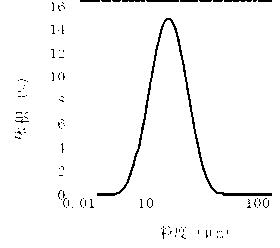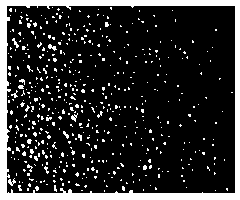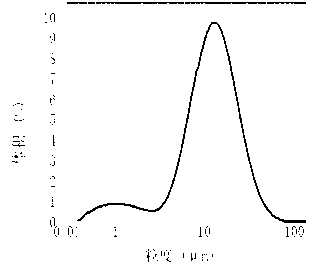Method for preparing lignin urea-formaldehyde pesticide microcapsule
A technology of lignin and microcapsules, which is applied in botany equipment and methods, animal repellents, biocides, etc., can solve the problems such as no reports of lignin microcapsule wall materials, and realize resource utilization and improve Utilization rate, effect of increasing reactivity
- Summary
- Abstract
- Description
- Claims
- Application Information
AI Technical Summary
Problems solved by technology
Method used
Image
Examples
Embodiment 1
[0058] Described raw material according to following proportioning:
[0059] Formaldehyde: urea = 1.75 (mass ratio), surfactant span85: deionized water = 3% (mass ratio), modified lignin: wall material (formaldehyde + urea + modified lignin) = 37.6% (mass ratio), abamectin: wall material (urea + formaldehyde + modified lignin) = 1 (mass ratio).
[0060] Add 1.333g of urea and 2.5ml of deionized water into the three-necked flask, stir to dissolve, adjust the pH value to 8~9 (using the range value) with 0.2mol / L sodium hydroxide solution, then add 3.0ml of formaldehyde, stir at 300rpm The temperature of the water bath was slowly raised to 75° C., and the stirring reaction was continued at this temperature for 80 min. Add 7.5 ml of an aqueous solution of modified lignin, and continue the reaction for 120 minutes to obtain a prepolymer solution, which is cooled to room temperature and placed.
[0061] The modification method of the lignin is: according to the ratio of 20g alkali...
Embodiment 2
[0065] Described raw material according to following proportioning:
[0066] Formaldehyde: urea = 1.75 (mass ratio), surfactant span85: deionized water = 3% (mass ratio), abamectin: wall material (urea + formaldehyde + modified lignin) = 1 (mass ratio ), wood modified quality: wall material (urea + formaldehyde + modified lignin) = 37.6% (mass ratio).
[0067] Weigh 1.333g of urea and 2.5ml of deionized water into a three-necked flask, stir and dissolve, adjust the pH to 8-9 with 0.2mol / L sodium hydroxide solution, then add 3.0ml of formaldehyde, and lower the temperature of the water bath at a stirring speed of 300rmp Slowly raise the temperature to 75°C, and keep stirring at this temperature for 80min. Add 7.5ml of modified lignin solution (refer to Example 1 for the preparation method), and continue to react for 120min to form a prepolymer solution. Then let cool to room temperature.
[0068] In the above prepolymer solution, add 12.0g of sodium chloride and 200ml of dei...
Embodiment 3
[0070] Described raw material according to following proportioning:
[0071] Formaldehyde: urea = 1.75 (mass ratio), surfactant span85: deionized water = 3% (mass ratio), modified lignin: wall material (formaldehyde + urea + modified lignin) = 44.6% (mass Ratio) Abamectin: wall material (urea + formaldehyde + modified lignin) = 0.5 (mass ratio).
[0072] Add 1.333g of urea and 2.5ml of deionized water into the three-necked flask, stir to dissolve, adjust the pH value to 8-9 with 0.2mol / L sodium hydroxide solution, then add 3.0ml of formaldehyde, and slowly lower the temperature of the water bath at a stirring speed of 300rpm Rise to 75°C, and keep stirring the reaction at the temperature for 70min. Add 10.0ml of modified lignin aqueous solution (refer to Example 1 for the preparation method), continue the reaction for 120min to obtain a prepolymer solution, cool to room temperature and place it.
[0073] In the above prepolymer solution, add 15.0g of sodium chloride and 200m...
PUM
 Login to View More
Login to View More Abstract
Description
Claims
Application Information
 Login to View More
Login to View More - R&D
- Intellectual Property
- Life Sciences
- Materials
- Tech Scout
- Unparalleled Data Quality
- Higher Quality Content
- 60% Fewer Hallucinations
Browse by: Latest US Patents, China's latest patents, Technical Efficacy Thesaurus, Application Domain, Technology Topic, Popular Technical Reports.
© 2025 PatSnap. All rights reserved.Legal|Privacy policy|Modern Slavery Act Transparency Statement|Sitemap|About US| Contact US: help@patsnap.com



